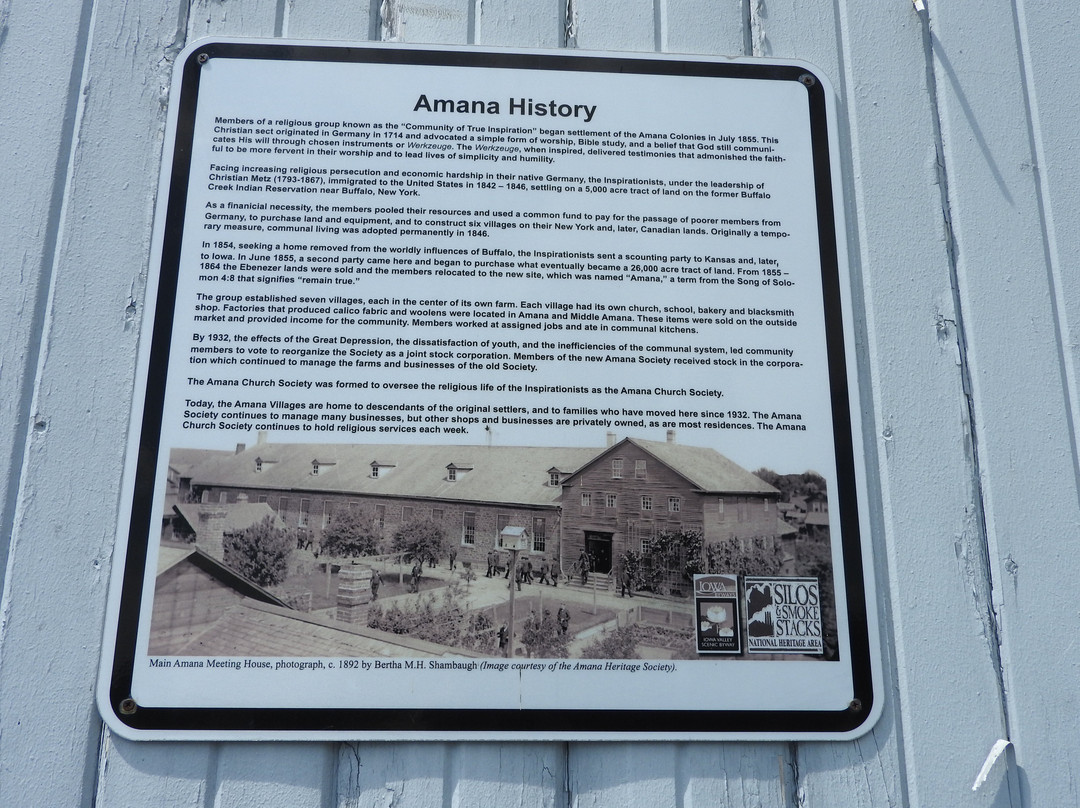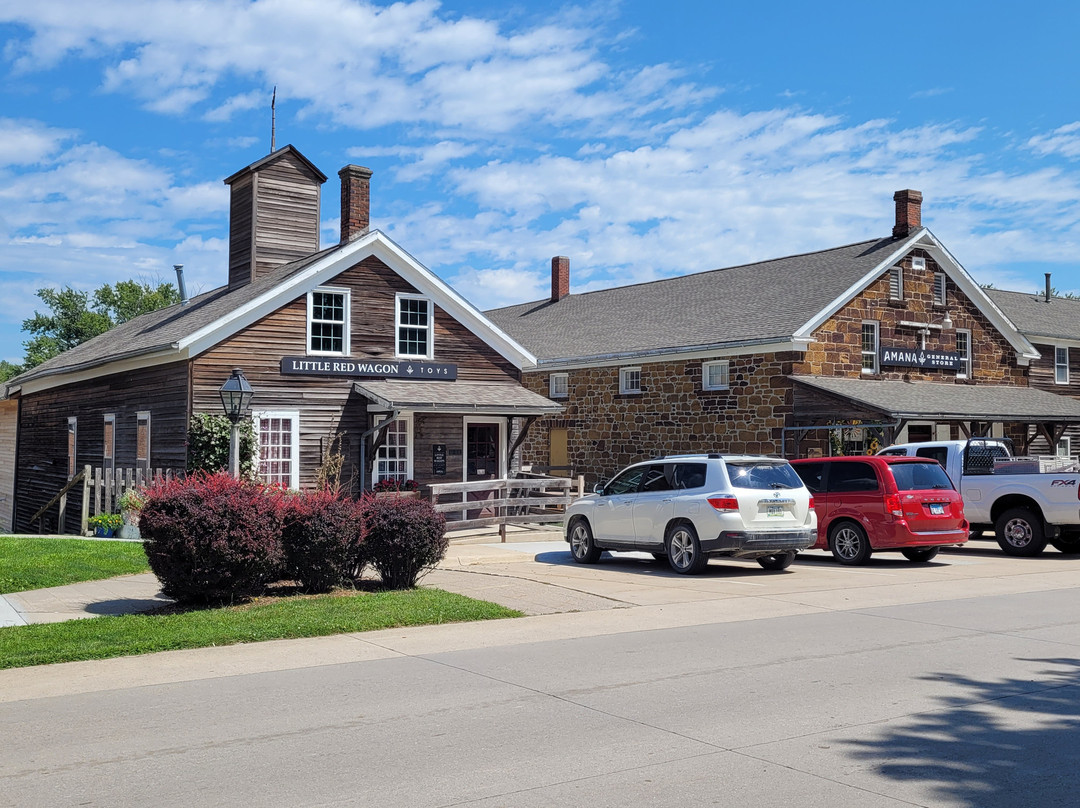的点评
Pleasant day of history museums and lots of shopping
Amana Colonies National Historic Landmark的点评
点评:We enjoyed spending most of a day in the Amana Colonies, which consists of 7 villages originally settled by a German religious community in the 1850s-1860s. The people lived as a communal society until they chose to change the way they governed themselves in 1932. The museums describe the work, home, and religious customs of the villagers during that time. These are the places we visited:
(1) East Amana: Did not visit.
(2) Amana: Amana Cemetery (where they originally buried in order of death, not in family plots); Amana Heritage Museum (history of the colonies); Ronneburg Restaurant (German food); Amana General Store (large modern gift shop with one side full of Christmas décor); Midwest Leather & Fudge Factory (leather goods and also candy); Visitor Center; Amana Woolen Mill (can peek inside the factory); Warped & Woven shop (really nice throw blankets, etc.).
(3) Middle Amana: Communal Kitchen (history of communal dining); Cooper Shop (history of communal work).
(4) High Amana: High Amana General Store (old-timey, local crafts).
(5) West Amana: Opa’s Tractor Barn Museum (neglected, not worth stopping at).
(6) South Amana: Henry Moore Barn Museum (closed; owner in bad health); Schantz Furniture (amazing workmanship, workshop on site, be sure to stop here).
(7) Homestead: Amana Community Church (history of local religious worship).
(1) East Amana: Did not visit.
(2) Amana: Amana Cemetery (where they originally buried in order of death, not in family plots); Amana Heritage Museum (history of the colonies); Ronneburg Restaurant (German food); Amana General Store (large modern gift shop with one side full of Christmas décor); Midwest Leather & Fudge Factory (leather goods and also candy); Visitor Center; Amana Woolen Mill (can peek inside the factory); Warped & Woven shop (really nice throw blankets, etc.).
(3) Middle Amana: Communal Kitchen (history of communal dining); Cooper Shop (history of communal work).
(4) High Amana: High Amana General Store (old-timey, local crafts).
(5) West Amana: Opa’s Tractor Barn Museum (neglected, not worth stopping at).
(6) South Amana: Henry Moore Barn Museum (closed; owner in bad health); Schantz Furniture (amazing workmanship, workshop on site, be sure to stop here).
(7) Homestead: Amana Community Church (history of local religious worship).
翻译:我们很享受在阿玛纳殖民地度过的大部分时间,该殖民地由 7 个村庄组成,最初由德国宗教社区在 19 世纪 50 年代至 60 年代定居。人们过着公社生活,直到 1932 年他们选择改变自己的治理方式。博物馆描述了当时村民的工作、家庭和宗教习俗。以下是我们参观的地方:
(1) 东阿玛纳:没有参观。
(2) 阿玛纳:阿玛纳公墓(他们最初按死亡顺序埋葬,而不是按家庭墓地埋葬);阿玛纳遗产博物馆(殖民地的历史);Ronneburg 餐厅(德国美食);阿玛纳百货商店(大型现代礼品店,一侧摆满了圣诞装饰);中西部皮革和软糖工厂(皮革制品和糖果);游客中心;阿玛纳羊毛厂(可以窥视工厂内部);Warped & Woven 商店(非常漂亮的毯子等)。
(3) 中阿马纳:公共厨房(公共用餐的历史);库珀商店(公共工作的历史)。
(4) 高阿马纳:高阿马纳杂货店(古老的当地工艺品)。
(5) 西阿马纳:奥帕拖拉机谷仓博物馆(被忽视,不值得停留)。
(6) 南阿马纳:亨利摩尔谷仓博物馆(已关闭;主人身体状况不佳);尚茨家具(工艺精湛,现场有工作室,一定要在这里停留)。
(7) 家园:阿马纳社区教堂(当地宗教崇拜的历史)。
(1) 东阿玛纳:没有参观。
(2) 阿玛纳:阿玛纳公墓(他们最初按死亡顺序埋葬,而不是按家庭墓地埋葬);阿玛纳遗产博物馆(殖民地的历史);Ronneburg 餐厅(德国美食);阿玛纳百货商店(大型现代礼品店,一侧摆满了圣诞装饰);中西部皮革和软糖工厂(皮革制品和糖果);游客中心;阿玛纳羊毛厂(可以窥视工厂内部);Warped & Woven 商店(非常漂亮的毯子等)。
(3) 中阿马纳:公共厨房(公共用餐的历史);库珀商店(公共工作的历史)。
(4) 高阿马纳:高阿马纳杂货店(古老的当地工艺品)。
(5) 西阿马纳:奥帕拖拉机谷仓博物馆(被忽视,不值得停留)。
(6) 南阿马纳:亨利摩尔谷仓博物馆(已关闭;主人身体状况不佳);尚茨家具(工艺精湛,现场有工作室,一定要在这里停留)。
(7) 家园:阿马纳社区教堂(当地宗教崇拜的历史)。



此点评仅代表旅行者个人的主观意见,并不代表TripAdvisor以及其合作方的意见。
关于我们
|
新闻动态
|
商务合作
|
会员中心
|
业主中心
|
业主通
|
常见问题
|
意见反馈
|
联系我们
|
营业执照
© 2025 Tripadvisor 版权所有。
使用条款 |隐私政策 |网站工作原理
部分照片由 VFM Leonardo 提供。
* Tripadvisor不是旅行社,也不是旅游预订服务代理商。我们提供免费、客观、公正的旅游资讯服务。 (显示更多)
TripAdvisor LLC 既不是预订代理商,也不是旅游运营商,不会向网站用户收取任何服务费。 按照规定,在 Tripadvisor 发布机票价格、游览和旅行套餐的合作伙伴(航空公司、旅行提供商及预订代理商),其标价须包含所有费用和附加费用。 例如, 机场出入境税费、消费税与其他服务费、手续费、杂费及附加费用。 当您向我们的某个合作伙伴进行预订时,请务必查阅他们的网站以了解当地行政部门要求的所有适用费用的具体情况。 除非另有说明,机票价格通常指的是一个人的价格(以人民币计)。
为方便起见,TripAdvisor LLC 根据从我们的预订合作伙伴获取的空房率计算每个酒店的均价。 对于游览和景点来说,所显示价格通常是每位成人的最低可用价格。 对于列出的任何旅行套餐或优惠,TripAdvisor LLC 无法保证任何特定的费率或价格。 此外,酒店均价每晚会更新,并以您的首选币种表示(使用现行汇率)。 由于这些已换算的价格是预估价格,因此,有关具体金额和币种请与预订网站进行核实。
此外,TripAdvisor LLC 无法保证我们网站上宣传的价格随时有效。 标价可能需要预订一定天数才能生效,或有不可用日期、使用条件或限制。
TripAdvisor公司对外部网站的内容一概不负责。优惠价格中不含税和其他费用。
ICP证:沪B2-20200433
沪ICP备20013175号
 沪公网安备31010502005427号
沪公网安备31010502005427号鹰程信息技术(上海)有限公司
货币/国家及地区
¥CNY
中国

